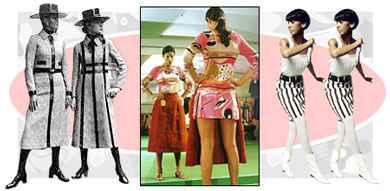Midi skirts

Fashion Synopsis
Fashion designers tried to end the reign of that 60’s icon called the miniskirt, by way of introducing the mid-calf-length midi skirt. But the undisputed queen of the sexually explosive 60’s wasn’t ready to step down, and neither were the girls who were buying and wearing the mini.
Once girls discovered the freedom of dressing for the sexual revolution, they weren’t going back. Girls liked the thigh-high mini to show off their shapely legs and celebrate their femininity, and the boys certainly weren’t complaining either. But the miniskirt had dominated the market long enough, and the fashion world needed a change. And what could be more different from the mini than the mid-calf midi? (Actually, the hippies answered that question with the maxi skirt, but fashion-conscious girls weren’t ready to go back to nature just yet).
The lowering of hemlines created a stir that matched the protests of the Vietnam War. Demonstrators swarmed the major department stores and threatened to boycott any store that took the mini off the shelves. A grassroots organization, GAMS: Girls Against More Skirt, fought for their beloved mini and protested with signs like ‘Keep the Mini on the Market.’ The youth revolution was ready to fight, and they were using the power of their voices and their wallets to make a difference.
The fashion world was in a quandary: the manufacturers made their money by changing over styles, and keeping a constant stream of money in the apparel market, but no one was buying the new midi. If girls were satisfied with their minis, and weren’t spending on new styles (a new skirt length also meant new shoes and new coats to match the new length), business wouldn’t survive. So manufacturers returned to manufacturing the mini in addition to the midi on the shelves.
The midi skirt did receive some attention in the wake of the 30’s revival brought on by the 1967 movie Bonnie and Clyde. Faye Dunaway’s role as a sexy gangster’s moll, decked out in 30’s-era midi skirts, sweaters, and berets helped to hold off the midi’s imminent demise. The sleek style of the midi was carried into the 70’s, when more of an ‘anything goes’ attitude was adopted by the fashion conscious. Minis, maxis, midis, and micros could be mixed up and worn any day of the week. Mini or midi skirts overlaid with a flowing maxi-coat became a popular way to intermingle the different lengths and make everyone happy.
Whether long or short, the 60’s were all about diversity and individuality. Manufacturers lost their power to dictate fashions blindly, without concern for the market. While most conservative adults maintained the proper knee length and only witnessed the headline wars from the sidelines, young adults helped to create the first fashion challenge, and won.
